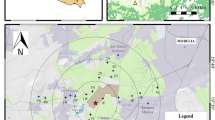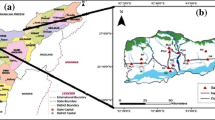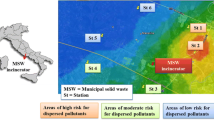Abstract
Several trace elements discharged by the petrochemical industry are toxic to humans and the ecosystem. In this study, we assessed airborne trace elements in the vicinity of the Map Ta Phut petrochemical industrial complex in Thailand by transplanting the lichen Parmotrema tinctorum to eight industrial, two rural, and one clean air sites between October 2013 and June 2014. After 242 days, the concentrations of As, Cd, Co, Cr, Cu, Hg, Mo, Ni, Pb, Sb, Ti, V, and Zn in lichens at most industrial sites were higher than those at the rural and the control sites; in particular, As, Cu, Mo, Sb, V, and Zn were significantly higher than at the control site (p < 0.05). Contamination factors (CFs) indicated that Cd, Cu, Mo, and Sb, which have severe health impacts, heavily contaminated at most industrial sites. Principal component analysis (PCA) showed that most elements were associated with industry, with lesser contributions from traffic and agriculture. Based on the pollution load indexes (PLIs), two industrial sites were highly polluted, five were moderately polluted, and one had a low pollution level, whereas the pollution load at the rural sites was comparable to background levels. This study reinforces the utility of lichens as cost-effective biomonitors of airborne elements, suitable for use in developing countries, where adequate numbers of air monitoring instruments are unavailable due to financial, technical, and policy constraints.


Similar content being viewed by others
References
Adriano DC (2001) Molybdenum. In: Adriano DC (ed) Trace elements in terrestrial environments: biogeochemistry, bioavailability, and risks of metals, 2nd edn. Springer Verlag, NY, pp 587–624
Achotegui-Castells A, Sardans J, Ribas À, Peñuelas J (2013) Identifying the origin of atmospheric inputs of trace elements in the Prades Mountains (Catalonia) with bryophytes, lichens, and soil monitoring. Environ Monit Assess 185:615–629
Adamo P, Giordano S, Vingiani S, Castaldo Cobianchi R, Violante P (2003) Trace element accumulation by moss and lichen exposed in bags in the city of Naples (Italy). Environ Pollut 122:91–103
ATSDR (1992) Toxicological profile for antimony and compounds. Atlanta, GA: Agency for Toxic Substances and Disease Registry (ATSDR)
ATSDR (2004a) Toxicological profile for cobalt. Atlanta, GA: Agency for Toxic Substances and Disease Registry (ATSDR)
ATSDR (2004b) Toxicological profile for copper. Atlanta, GA: Agency for Toxic Substances and Disease Registry (ATSDR)
ATSDR (2014) Summary data for 2013 priority list of hazardous substances. Atlanta, GA: Agency for Toxic Substances and Disease Registry (ATSDR)
Bajpai R, Shukla V, Upreti DK, Semwal M (2014) Selection of suitable lichen bioindicator species for monitoring climatic variability in the Himalaya. Environ Sci Pollut Res 21:11380–11394
Bargagli R, Mikhailova I (2002) Accumulation of inorganic contaminations. In: Nimis PL, Scheidegger C, Wolseley PA (eds) Monitoring with lichens—monitoring lichens. Kluwer Academic, Dordrecht, pp 65–84
Bari A, Rosso A, Minciardi M, Troiani F, Piervittori R (2001) Analysis of heavy metals in atmospheric particulates in relation to their bioaccumulation in explanted Pseudevernia furfuracea thalli. Environ Monit Assess 69:205–220
Bergamaschi L, Rizzio E, Giaveri G, Profumo A, Loppi S, Gallorini M (2004) Determination of baseline element composition of lichens using samples from high elevations. Chemosphere 55:933–939
Boamponsem LK, Adam JI, Dampare SB, Nyarko BJB, Essumang DK (2010) Assessment of atmospheric heavy metal deposition in the Tarkwa gold mining area of Ghana using epiphytic lichens. Nucl Instrum Methods Phys Res B 268:1492–1501
Boonpragob K, Nash TH III (1990) Seasonal variation of elemental status in the lichen Ramalina menziesii Tayl. from two sites in southern California: evidence for dry deposition accumulation. Environ Exp Bot 30:415–428
Boyer RR (2010) Attributes, characteristics, and applications of titanium and its alloys. JOM 62:21–24
Branquinho C, Gaio-Oliveira G, Augusto S, Pinho P, Máguas C, Correia O (2008) Biomonitoring spatial and temporal impact of atmospheric dust from a cement industry. Environ Pollut 151:292–299
Brown DH, Brown RM (1991) Mineral cycling and lichens: the physiological basis. Lichenologist 23:293–307
Brunialti G, Frati L (2007) Biomonitoring of nine elements by the lichen Xanthoria parietina in Adriatic Italy: a retrospective study over a 7-year time span. Sci Total Environ 387:289–300
Canha N, Almeida SM, Freitas MC, Wolterbeek HT (2014) Indoor and outdoor biomonitoring using lichens at urban and rural primary schools. J Toxicol Environ Health A 77:900–915
Conti ME, Pino A, Botrè F, Bocca B, Alimonti A (2009) Lichen Usnea barbata as biomonitor of airborne elements deposition in the Province of Tierra del Fuego (southern Patagonia, Argentina). Ecotox Environ Safe 72:1082–1089
Corapi A, Gallo L, Nicolardi V, Lucadamo L, Loppi S (2014) Temporal trends of element concentrations and ecophysiological parameters in the lichen Pseudevernia furfuracea transplanted in and around an industrial area of S Italy. Environ Monit Assess 186:3149–3164
Darnajoux R, Lutzoni F, Miadlikowska J, Bellenger J-P (2015) Determination of elemental baseline using peltigeralean lichens from northeastern Canada (Québec): initial data collection for long term monitoring of the impact of global climate change on boreal and subarctic area in Canada. Sci Total Environ 533:1–7
Demiray AD, Yolcubal I, Akyol NH, Çobanoğlu G (2012) Biomonitoring of airborne metals using the lichen Xanthoria parietina in Kocaeli Province, Turkey. Ecol Indic 18:632–643
Dohi T, Ohmura Y, Kashiwadani H, Fujiwara K, Sakamoto Y, Iijima K (2015) Radiocaesium activity concentrations in parmelioid lichens within a 60 km radius of the Fukushima Dai-ichi Nuclear Power Plant. J Environ Radioact 146:125–133
Frati L, Brunialti G, Loppi S (2005) Problems related to lichen transplants to monitor trace element deposition in repeated surveys: a case study from central Italy. J Atmos Chem 52:221–230
Ferreira AB, Saiki M, Santos JO, Ribeiro AP, Saldiva PHN (2012) Elemental composition evaluation in lichens collected in the industrial city of São Mateus Sul, Paraná, Brazil. J Radioanal Nucl Chem 291:71–76
Garty J, Garty-Spitz RL (2015) Lichens and particulate matter: inter-relations and biomonitoring with lichens. In: Upreti DK, Divakar PK, Shukla V, Bajpai R (eds) Recent advances in lichenology: modern methods and approaches in biomonitoring and bioprospection, vol 1. Springer, New Delhi, pp 47–85
Giordano S, Adamo P, Spagnuolo V, Tretiach M, Bargagli R (2013) Accumulation of airborne trace elements in mosses, lichens and synthetic materials exposed at urban monitoring stations: towards a harmonisation of the moss-bag technique. Chemosphere 90:292–299
Godinho RM, Wolterbeek HT, Verburg T, Freitas MC (2008) Bioaccumulation behaviour of transplants of the lichen Flavoparmelia caperata in relation to total deposition at a polluted location in Portugal. Environ Pollut 151:318–325
Godt J, Scheidig F, Grosse-Siestrup C, Esche V, Brandenburg P, Reich A, Groneberg DA (2006) The toxicity of cadmium and resulting hazards for human health. J Occup Med Toxicol 1:22
Grangeon S, Guédron S, Asta J, Sarret G, Charlet L (2012) Lichen and soil as indicators of an atmospheric mercury contamination in the vicinity of a chlor-alkali plant (Grenoble, France). Ecol Indic 13:178–183
Hair JF Jr, Black WC, Babin BJ, Anderson RE (2009) Exploratory factor analysis. In: Hair JF Jr, Black WC, Babin BJ, Anderson RE (eds) Multivariate data analysis. Pearson-Prentice Hall, Upper Saddle River, pp 91–152
Jadsri S, Singhasivanon P, Kaewkungwal J, Sithiprasasna R, Siriruttanapruk S, Konchom S (2006) Spatio-temporal effects of estimated pollutants released from an industrial estate on the occurrence of respiratory disease in Maptaphut Municipality, Thailand. Int J Health Geogr 5:48
Käffer MI, Lemos AT, Apel MA, Rocha JV, Martins SMA, Vargas VMF (2012) Use of bioindicators to evaluate air quality and genotoxic compounds in an urban environment in southern Brazil. Environ Pollut 163:24–31
Kampa M, Castanas E (2008) Human health effects of air pollution. Environ Pollut 151:362–367
Kongtip P, Singkaew P, Yoosook W, Chantanakul S, Sujiratat D (2013) Health effects of people living close to a petrochemical industrial estate in Thailand. J Med Assoc Thail 96:S64–S72
Koz B, Celik N, Cevik U (2010) Biomonitoring of heavy metals by epiphytic lichen species in Black Sea region of Turkey. Ecol Indic 10:762–765
Kularatne KIA, de Freitas CR (2013) Epiphytic lichens as biomonitors of airborne heavy metal pollution. Environ Exp Bot 88:24–32
Langkulsen U, Vichit-Vadakan N, Taptagaporn S (2011) Safety and health in the petrochemical industry in Map Ta Phut, Thailand. J Occup Health 53:384–392
Leonardo L, Mazzilli BP, Damatto SR, Saiki M, Barros de Oliveira SM (2011) Assessment of atmospheric pollution in the vicinity of a tin and lead industry using lichen species Canoparmelia texana. J Environ Radioactiv 102:906–910
Loppi S, Paoli L (2015) Comparison of the trace element content in transplants of the lichen Evernia prunastri and in bulk atmospheric deposition: a case study from a low polluted environment (C Italy). Biologia 70:460–466
Louwhoff HJJ, Elix JA (2000) The lichens of Rarotonga, Cook Islands, South Pacific Ocean II: Parmeliaceae. Lichenologist 32:49–55
Lucadamo L, Corapi A, Loppi S, De Rosa R, Barca D, Vespasiano G, Gallo L (2016) Spatial variation in the accumulation of elements in thalli of the lichen Pseudevernia furfuracea (L.) Zopf transplanted around a biomass power plant in Italy. Arch Environ Contam Toxicol 70:506–521
Malaspina P, Tixi S, Brunialti G et al (2014) Biomonitoring urban air pollution using transplanted lichens: element concentrations across seasons. Environ Sci Pollut Res 21:12836–12842
Mikhailova IN, Sharunova IP (2008) Dynamics of heavy metal accumulation in thalli of the epiphytic lichen Hypogymnia physodes. Russ J Ecol 39:346–352
Nadal M, Mari M, Schuhmacher M, Domingo JL (2009) Multi-compartmental environmental surveillance of a petrochemical area: levels of micropollutants. Environ Int 35:227–235
Nannoni F, Santolini R, Protano G (2015) Heavy element accumulation in Evernia prunastri lichen transplants around a municipal solid waste landfill in central Italy. Waste Manag 43:353–362
Ng OH, Tan BC, Obbard JP (2005) Lichens as bioindicators of atmospheric heavy metal pollution in Singapore. Environ Monit Assess 123:63–74
Nimis PL, Lazzarin G, Lazzarin A, Skert N (2000) Biomonitoring of trace elements with lichens in Veneto (NE Italy). Sci Total Environ 255:97–111
Odiwe A, Adesanwo AJ, Olowoyo J, Raimi I (2014) Assessment of trace metals using lichen transplant from automobile mechanic workshop in Ile-Ife metropolis, Nigeria. Environ Monit Assess 186:2487–2494
Olowoyo J, van Heerden E, Fischer JL (2011) Trace element concentrations from lichen transplants in Pretoria, South Africa. Environ Sci Pollut Res 18:663–668
Paoli L, Corsini A, Bigagli V, Vannini J, Bruscoli C, Loppi S (2012) Long-term biological monitoring of environmental quality around a solid waste landfill assessed with lichens. Environ Pollut 161:70–75
Paoli L, Munzi S, Guttová A, Senko D, Sardella G, Loppi S (2015) Lichens as suitable indicators of the biological effects of atmospheric pollutants around a municipal solid waste incinerator (S Italy). Ecol Indic 52:362–370
Pimpisut D, Jinsart W, Hooper MA (2005) Modeling of the BTX species based on an emission inventory of sources at the Map Ta Phut Industrial Estate in Thailand. Sci Asia 31:103–112
Purvis OW, Williamson BJ, Spiro B, Udachin V, Mikhailova IN, Dolgopolova A (2013) Lichen monitoring as a potential tool in environmental forensics: case study of the Cu smelter and former mining town of Karabash, Russia. Geol Soc Lond, Spec Publ 384:133–146
Rangkadilok N, Siripriwon P, Nookabkaew S, Suriyo T, Satayavivad J (2015) Arsenic, cadmium, and manganese levels in shellfish from Map Ta Phut, an industrial area in Thailand, and the potential toxic effects on human cells. Arch Environ Contam Toxicol 68:169–180
Rojas-Rodríguez AD, Flores-Fajardo O, González FSA, Castillo NNL, Gómez MJC (2012) Chemical treatment to recover molybdenum and vanadium from spent heavy gasoil hydrodesulfurization catalyst. Adv Chem Engineer Sci 2:408–412
Rusu AM (2002) Sample preparation of lichens for elemental analysis. In: Nimis PL, Scheidegger C, Wolseley PA (eds) Monitoring with lichens—monitoring lichens. Kluwer Academic, Dordrecht, pp 305–309
Salo H, Bućko MS, Vaahtovuo E, Limo J, Mäkinen J, Pesonen LJ (2012) Biomonitoring of air pollution in SW Finland by magnetic and chemical measurements of moss bags and lichens. J Geochem Explor 115:69–81
Sangiamdee D (2014) Validation of sample preparation methods for determination of metal accumulation in lichen Parmotrema tinctorum by inductively coupled plasma mass spectrometry (ICP-MS). Master’s Thesis, Ramkhamhaeng University
Scerbo R, Ristori T, Possenti L, Lampugnani L, Barale R, Barghigiani C (2002) Lichen (Xanthoria parietina) biomonitoring of trace element contamination and air quality assessment in Pisa Province (Tuscany, Italy). Sci Total Environ 286:27–40
Singkaew P, Kongtip P, Yoosook W, Chantanakul S (2013) Health risk assessment of volatile organic compounds in a high risk group surrounding Map Ta Phut industrial estate, Rayong Province. J Med Assoc Thail 96:S73–S81
Sloof JE (1995) Lichens as quantitative biomonitors for atmospheric trace-element deposition, using transplants. Atmos Environ 29:11–20
Søndergaard J (2013) Dispersion and bioaccumulation of elements from an open-pit olivine mine in southwest Greenland assessed using lichens, seaweeds, mussels and fish. Environ Monit Assess 185:7025–7035
Sorbo S, Aprile G, Strumia S, Castaldo Cobianchi R, Leone A, Basile A (2008) Trace element accumulation in Pseudevernia furfuracea (L.) Zopf exposed in Italy’s so called Triangle of Death. Sci Total Environ 407:647–654
Sujetoviene G, Sliumpaite I (2013) Response of Evernia prunastri transplanted to an urban area in central Lithuania. Atmos Pollut Res 4:222–228
Sundar S, Chakravarty J (2010) Antimony toxicity. Int J Environ Res Public Health 7:4267–4277
Tanyanont W, Vichit-Vadakan N (2012) Exposure to volatile organic compounds and health risks among residents in an area affected by a petrochemical complex in Rayong, Thailand. Southeast Asian J Trop Med Public Health 43:201–211
Tomlinson DL, Wilson JG, Harris CR, Jeffrey DW (1980) Problems in the assessment of heavy-metal levels in estuaries and the formation of a pollution index. Helgolander Meeresunters 33:566–575
Vyskocil A, Viau C (1999) Assessment of molybdenum toxicity in humans. J Appl Toxicol 19:185–192
Wannalux B (2014) The growth and longevity of tropical lichens of Khao Yai National Park. Master’s thesis, Ramkhamhaeng University
WHO (2010) Exposure to cadmium: a major public health concern. Geneva, Switzerland: World Health Organization (WHO)
Will-Wolf S, Makholm MM, Nelsen MP, Trest MT, Reis AH, Jovan S (2015) Element analysis of two common macrolichens supports bioindication of air pollution and lichen response in rural midwestern U.S.A. Bryologist 118:371–384
Wolterbeek B (2002) Biomonitoring of trace element air pollution: principles, possibilities and perspectives. Environ Pollut 120:11–21
Yemets OA, Solhaug KA, Gauslaa Y (2014) Spatial dispersal of airborne pollutants and their effects on growth and viability of lichen transplants along a rural highway in Norway. Lichenologist 46:809–823
Zeng X, Liu Y, You S et al (2015) Spatial distribution, health risk assessment and statistical source identification of the trace elements in surface water from the Xiangjiang River, China. Environ Sci Pollut Res 22:9400–9412
Zhang Q, Li Z, Zeng G et al (2009) Assessment of surface water quality using multivariate statistical techniques in red soil hilly region: a case study of Xiangjiang watershed, China. Environ Monit Assess 152:123–131
Zhang ZH, Chai ZF, Mao XY, Chen JB (2002) Biomonitoring trace element atmospheric deposition using lichens in China. Environ Pollut 120:157–161
Zvěřina O, Láska K, Červenka R, Kuta J, Coufalík P, Komárek J (2014) Analysis of mercury and other heavy metals accumulated in lichen Usnea antarctica from James Ross Island, Antarctica. Environ Monit Assess 186:9089–9100
Acknowledgments
We would like to thank the Science Achievement Scholarship of Thailand (SAST) for granting a scholarship to C. Boonpeng. We would like to give a very special thanks to all of our colleagues at the Lichen Research Unit, as well as all relevant officers at all study areas for their assistance. We are also thankful to three anonymous reviewers for their valuable suggestions and comments. This work was funded by the National Research Council of Thailand (NRCT).
Author information
Authors and Affiliations
Corresponding author
Additional information
Responsible editor: Philippe Garrigues
Rights and permissions
About this article
Cite this article
Boonpeng, C., Polyiam, W., Sriviboon, C. et al. Airborne trace elements near a petrochemical industrial complex in Thailand assessed by the lichen Parmotrema tinctorum (Despr. ex Nyl.) Hale. Environ Sci Pollut Res 24, 12393–12404 (2017). https://doi.org/10.1007/s11356-017-8893-9
Received:
Accepted:
Published:
Issue Date:
DOI: https://doi.org/10.1007/s11356-017-8893-9




